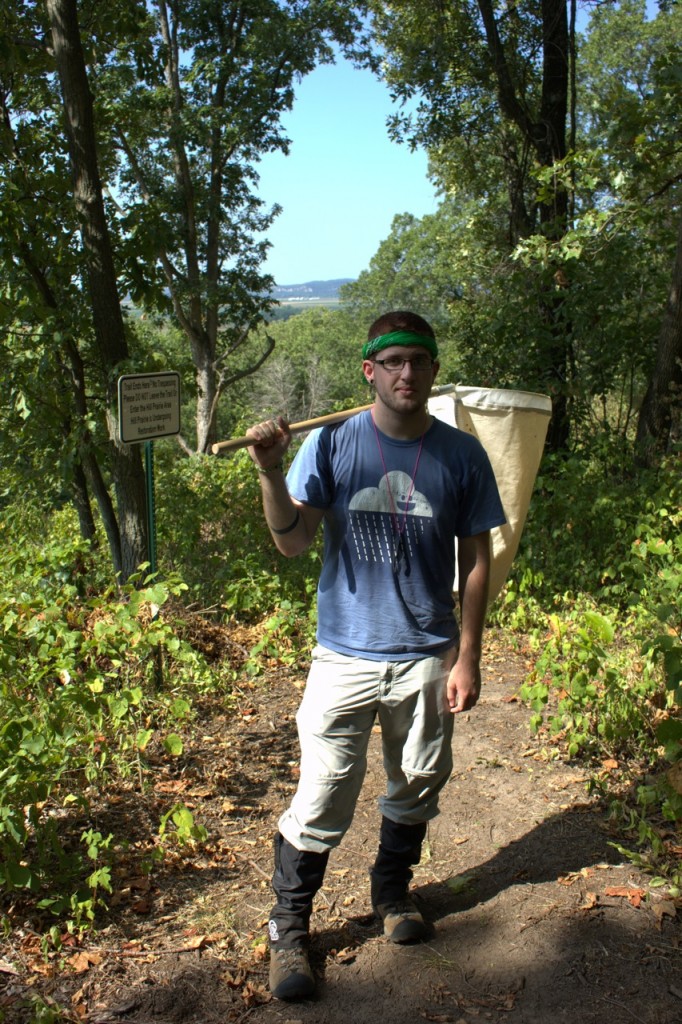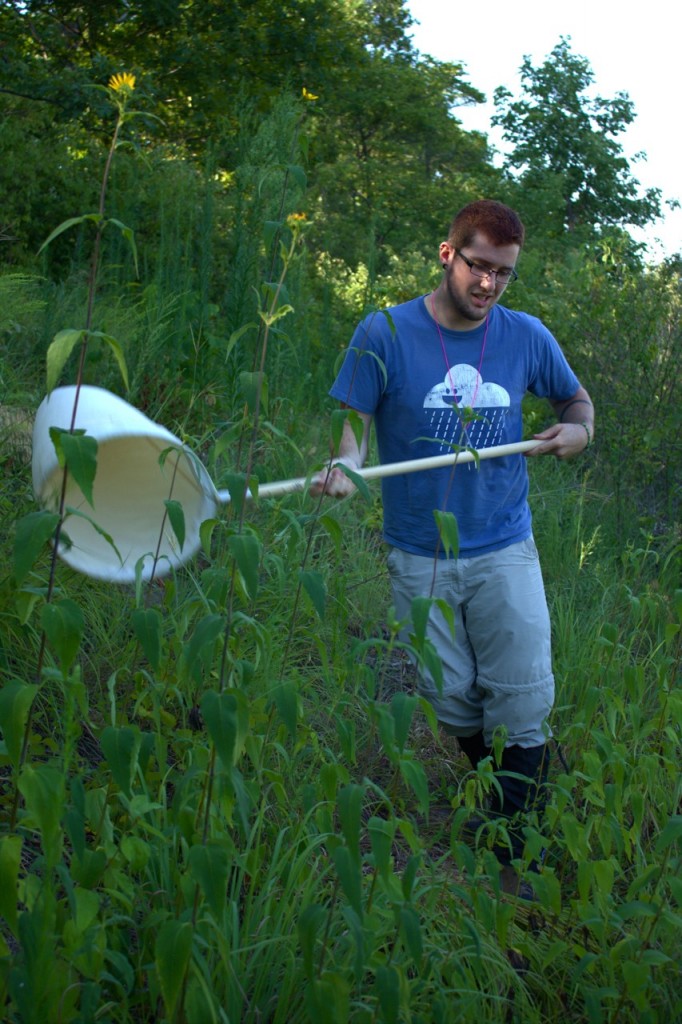Mississippi River Bluff Ecosystems Are Studied for Biodiversity

SEMO graduate student Korey Byers has conducted field research for two years at White Rock Nature Preserve. Photo courtesy Ethan Orsburn, SEMO.
Our Mississippi River bluff land corridor is one of the most diverse natural areas in Illinois. The corridor constitutes its own ecosystem – the Northern Ozark Natural Division – and stands on its own singular geologic formation — the Salem Plateau – both science-based measures of the region’s uniqueness in the state.
An ecosystem is simply the sum total of all living organisms in a specific place. An ecosystem survives on a nexus of interdependent biological networks and relationships, with each living organism gaining shelter and sustenance from its co-inhabitants. And each ecosystem contains distinctive biological features, with its own unique list of organisms providing mutual benefits to each other. The enduring strength of an ecosystem is built around this mutuality of services.
Our bluff land ecosystem provides us a wealth of such services. Wild game and mushroom foods, timber production, wood fuels and illusive patches of medicinal plants are obvious products of our forests’ bounty. But the bluff lands’ huge forested landscape — one of the largest contiguous woodlands in the state – provides many additional services.
The forest canopy and soil microbes purify air by filtering particulates and providing chemical reaction sites where pollutants are detoxified. Forest canopy and leaf litter protect the soil surface from the erosive power of rain. Forest trees and other plants store carbon and help to slow the course of global heating by regulating localized climate. It’s a no brainer that on a sweltering summer day the bluff lands remain considerably cooler than surrounding urbanized areas.
Our forests also maintain the water cycle, bind soils and prevent erosion. Deeper pockets of forest soil assist in storing water; and, all the soils help purify ground water, acting as a massive filtration system.
The bluff lands’ expansive quantities of plant life, generated each year through the process of photosynthesis, produce massive amounts of energy, forming the basis of an interrelated food chain, which powers the ecosystem to provide additional ecological services. Critical nutrient cycling, flowering plant reliance on animal pollinators, and effective seed dispersal all depend on the mutual collaboration of biota within the ecosystem.
Our bluff lands ecosystem also provides intangible services to human residents on a psychological level. Outdoor recreation in the bluffs contributes to our physical well being, and the stunning viewscapes and beauty of many of our natural areas bring emotional satisfaction to many local residents.
A critical factor for the health and sustainability of our bluff land ecosystem is the biological native species diversity in the corridor. Native plant and animal species diversity acts as a kind of an insurance policy for our bluff land ecosystem, buffering our corridor against such stresses as temperature changes, diseases and pests, and man-made and nature-made disruptions.
The larger the number of native species means a greater capacity to self-sustain the system. With a higher species diversity, there is a greater redundancy of functional groups of wildlife, and, as a consequence, greater ecosystem resiliency. For example, if one species of soil decomposing bacteria dies out in our corridor, there are other species to take up the functional slack.
The functioning of our bluff land ecosystem is simply, critically and totally dependent on the diversity of its constituent species and populations, and it is this functioning that allows our bluff ecosystem to provide essential goods and services to keep us humans and all of our fellow plant and animal inhabitants alive.
We know only a little about native species diversity in the bluff lands. Over the last decade natural history surveys in the bluff lands have cataloged 280 species of birds, about 800 species of plants, 46 species of mammals, 62 species of reptiles and amphibians, and almost 90 species of butterflies. But there is much, much more we don’t know.
Natural history records for the bluff lands, assembled over the last 150 years, indicate there should be about 1000 species of plants in the ecosystem. We don’t know how many of these species have died off or been supplanted by non-native species. We know almost nothing about insect life in the corridor. And we understand very little about non-flowering / non-vascular plant species (mosses, liverworts and fungi) in the region.
Bio-diversity surveys and inventories require a host of experts, continuous all-seasons field trips, and the cooperation and coordination of many dedicated institutions, agencies, societies and volunteers. The survey/inventory effort in our bluff lands has proceeded in both big and small ways.
Large “bio-blitzes” were conducted at Salt Lick Point Land & Water Reserve in Monroe County in 2011 and at the Mill Creek Natural Area in Randolph County in 2013. In both cases, scientists and naturalists came from all over Illinois and Missouri to conduct the surveys. The University of Illinois has launched a multi-year soil microbial study in the corridor. The Illinois Natural History Survey is conducting several mammal and cave fauna studies in our region. SWIC is conducting several herpetofaunal surveys in the corridor. Volunteers from the Illinois Audubon Society and Illinois Ornithological Society are conducting routine bird surveys and have instituted both Spring and Christmas Bird Counts in the corridor.
Thus far the results are impressive. Five amphibian-reptilian species, previously not recorded in the area, now have been documented in the corridor; six bird species, previously shown as rare visitors or migrants only, have proven to be breeding here, and seven native plant species, previously unrecorded in the region, have been identified.
And, Southeast Missouri State University’s Biology Department is taking the lead with long-needed insect studies in our region. With 60,000 to 90,000 species of insects in the state, and little known about their distribution, entomological surveys are long overdue. A study of ant species is underway at Fults Hill Prairie Nature Preserve and a weevil study is being conducted at White Rock Nature Preserve. Weevils are small, herbivorous beetles and have been long-overlooked on our natural areas landscape.
Clifftop is hosting a seminar on the “Weevils at White Rock” on Saturday, November 2nd, at 1 PM at the Monroe County Annex Building, 100 Illinois Avenue, in Waterloo. Korey Byers, SEMO graduate student, will discuss the results of his two-year study at the White Rock Nature Preserve. The seminar is free and open to the public. Pre-registration, by 1 November, is required at clifftop@htc.net or 458-4674.
CLIFFTOP, a local nonprofit organization, is focused on preserving and protecting area bluff lands.
A version of this article appeared in the 1 November 2013 edition of the Monroe County Independent.
© 2013 all content rights reserved Clifftop NFP
Comments are currently closed.

